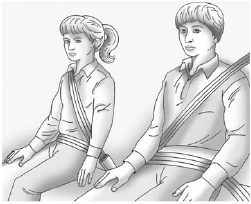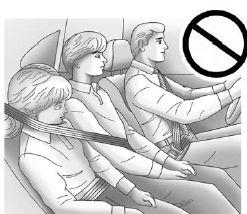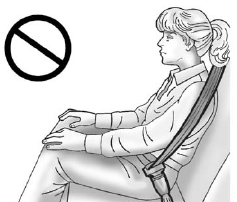Older Children

Older Children
Older children who have outgrown booster seats should wear the vehicle's safety belts.
The manufacturer's instructions that come with the booster seat, state the weight and height limitations for that booster. Use a booster seat with a lap-shoulder belt until the child passes the below fit test:
• Sit all the way back on the seat.
Do the knees bend at the seat edge? If yes, continue. If no, return to the booster seat.
• Buckle the lap-shoulder belt.
Does the shoulder belt rest on the shoulder? If yes, continue.
If no, then return to the booster seat.
• Does the lap belt fit low and snug on the hips, touching the thighs? If yes, continue. If no, return to the booster seat.
• Can proper safety belt fit be maintained for the length of the trip? If yes, continue. If no, return to the booster seat.
Q: What is the proper way to wear safety belts?
A: An older child should wear a lap-shoulder belt and get the additional restraint a shoulder belt can provide. The shoulder belt should not cross the face or neck. The lap belt should fit snugly below the hips, just touching the top of the thighs.
This applies belt force to the child's pelvic bones in a crash.
It should never be worn over the abdomen, which could cause severe or even fatal internal injuries in a crash.
According to accident statistics, children and infants are safer when properly restrained in a child restraint system or infant restraint system secured in a rear seating position.
In a crash, children who are not buckled up can strike other people who are buckled up, or can be thrown out of the vehicle. Older children need to use safety belts properly.
WARNING!
Never do this.
Never allow two children to wear
the same safety belt. The safety
belt cannot properly spread the
impact forces. In a crash, the two
children can be crushed together
and seriously injured. A safety
belt must be used by only one
person at a time.

WARNING!
Never do this.
Never allow a child to wear the
safety belt with the shoulder belt
behind their back. A child can be
seriously injured by not wearing
the lap-shoulder belt properly. In a
crash, the child would not be
restrained by the shoulder belt.
The child could move too far
forward increasing the chance of
head and neck injury. The child
might also slide under the lap
belt. The belt force would then be
applied right on the abdomen.
That could cause serious or fatal
injuries. The shoulder belt should
go over the shoulder and across
the chest.

See also:
Engine Air Cleaner/Filter
See Engine Compartment Overview for
the location of the engine air cleaner/filter. ...
The Comfort Story
The CX is more comfortable than the higher trim levels I've driven, for one
reason: the cloth seats. It's not the upholstery itself; it's the seat design.
Both I and another editor found the leath ...
Trailer Towing (Except eAssist)
Before pulling a trailer, there are
three important considerations that
have to do with weight:
• The weight of the trailer.
• The weight of the trailer tongue.
• The total weight on your ...


